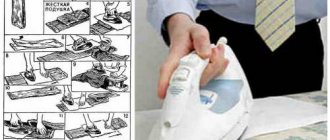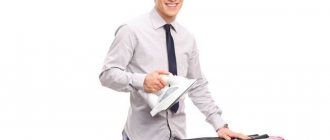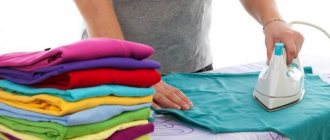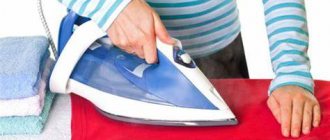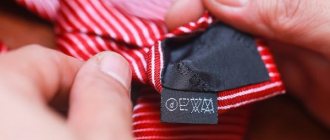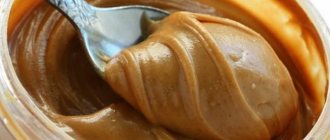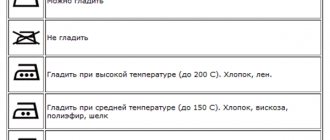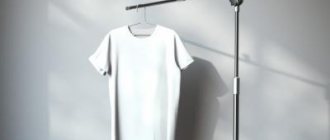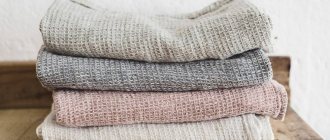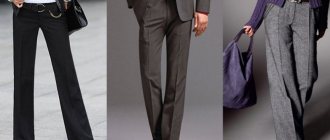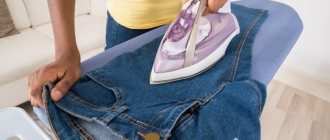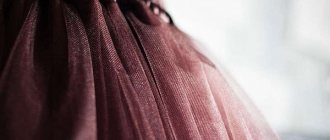Read: 631
We judge a person not only by his appearance, but also by the way he speaks. It is speech that provides complete information about a stranger: his education, social status, interests, profession.
That is why it is important to correctly use professional terms in everyday life and know some of the secrets of the culture of Russian speech. Quite often, disputes arise regarding the use of a particular word.
If you do not have a specialized philological education, it is quite difficult to answer this question right away. But it is he who often becomes the subject of controversy. Well, it's time to give a comprehensive explanation.
Read in this article:
- How to say - ironing or ironing?
- Professional vocabulary
- Ironing or ironing?
- When can you use ironing?
Ironing or ironing - which is correct?
- The verb Iron has a fairly wide application - it can be used in relation to any action that is accompanied by aligning or holding something over something. You can iron laundry by running an iron over it, you can stroke a person by running your palm over it, you can stroke an animal, a railing, or any object. It is correct and acceptable to say this about ironing clothes.
The word Iron has a narrower meaning, namely to iron with either an iron or some kind of heavy object. This verb is formed from the noun Iron and has the same root as it. Therefore, using it in relation to the process of ironing clothes is also correct and also acceptable.
You can say whatever you like best.
- Good afternoon, if you are in doubt which option is correct, then in this case you can use both options. Therefore, if you want to describe the process that is performed by an iron, then you can use any option: ironing or ironing.
- According to the rules, of course, when talking about an iron, we should use the word quot; ironquot;, but, as they say,
Therefore, the majority of Russian-speaking citizens are the most quot; insolentquot; way they break this rule and say quot; ironquot;. And only vigilant teachers of sewing technology in schools do not sleep and disgruntledly correct quot; carelessquot; schoolgirls who do not want to use a strange and unusual word in everyday life for the sake of linguistic decency invented by someone. And they can be understood. As the saying goes,
99% of people do not use this word in ordinary conversation. So why, one might ask, should people be loaded? If we made two acceptable options, everyone would be happy. And why such pedantry? If one asks another to iron the bed linen, then in 99.99999% of cases an adequate person will turn on the iron and do what is needed, and will not smooth it with his hand like a cat, because he supposedly did not understand what he was talking about))).
- If you are petting a cat, then it is correct to say pet. If you want to iron your bed linen, then in this case it is correct to say iron. But many people speak incorrectly because they are used to it. More often they say that they will iron the clothes.
- Iron.
This ambiguous verb can be used in the following meanings: quot;smooth with an ironquot;, quot;smooth with any pressquot;, quot;stroke or smooth any surface with somethingquot;, quot;caressquot; and even quot; beatquot; (colloquially).
Iron.
An even more ambiguous verb, but its first meaning is to intensively, diligently and carefully iron (for example, some clothes). The remaining meanings are quot; to stroke or smooth with the hand in movements reminiscent of the operation of an ironquot;, quot; to move like an ironquot;, quot; to intensively destroy something (for example, by bombing)quot;, quot; to scold or beat someonequot;.
Thus, in order to apply one or another verb to different contexts, you need to be well versed in the meanings of the words quot; ironquot; and quot;ironquot;:
- The man made several leisurely, light movements with the iron on the surface of the handkerchief. He stroked it.
- Enemy bombers swept over the city, showering it with shells. They did not iron the city, but ironed it.
- The guy touched the girl’s hand and ran his fingers from the hand to the shoulder. He did not iron the girl, but stroked her.
Then he took the second scarf and began to smooth it out with all his strength and speed. He ironed it.
But in my opinion, the term ironing is more professional. That's what seamstresses usually say. And other people usually iron clothes.
quot;Ironingquot; and quot; ironquot; - these are synonyms, both options can be used. Since quot; ironquot; - this is also quot; to give a smooth lookquot;.
info-4all.ru
Disadvantages of ironing
But some studies say that high temperatures are contraindicated for bedding sets. So why can't you iron your bed linen?
The main argument for stopping ironing bed linen
- Ironing bedding is a waste of time and effort. The same time could be spent with family and loved ones.
- You need to be in an uncomfortable position for a long time, which can negatively affect your back and overall health.
- If your bed linen is made from natural fabrics, the hygroscopicity of the material will decrease. What does it mean? The fabric will allow less air to pass through, which means that the skin will not breathe at night.
- Moreover, it is useless to iron bedding sets in the summer. Firstly, it is a real torment during the heat. And secondly, ironed fabric absorbs sweat less well, so the quality of your sleep will decrease.
- Very large waste of electricity, especially in large families where several sets need to be ironed at once.
- At night, especially if you move a lot in your sleep, the fabric still wrinkles, so after the first use the impeccable smoothness will disappear.
- After ironing, fabrics accumulate static electricity, which can make it difficult to fall asleep and keep your sleep shallow.
- If you add conditioner during washing, you won’t need to iron your clothes at all. Just remember that in this case the set must be dried flat.
- If your washing machine has an “easy iron” mode, then all you have to do after washing is hang out the wet clothes.
- Not all things need ironing to maintain their appearance. Many manufacturers specifically add synthetic fibers to the composition. So, polyester makes the product more durable, which prolongs the life of the set.
Iron or iron – how to say it correctly?
We judge a person not only by his appearance, but also by the way he speaks. It is speech that provides complete information about a stranger: his education, social status, interests, profession.
That is why it is important to correctly use professional terms in everyday life and know some of the secrets of the culture of Russian speech. Quite often, disputes arise regarding the use of a particular word.
If you do not have a specialized philological education, it is quite difficult to answer this question right away. But it is he who often becomes the subject of controversy. Well, it's time to give a comprehensive explanation.
Read in this article:
Are we ironing or ironing?
In the Russian language there is a concept of variability of language norms. This means that we can express the same concept in different words, differing only in stylistic shades. This does not interfere with understanding each other at all. For example, such options include the pairs “bard - poet” or “ice - ice”. But as for the words iron or iron - how to use them correctly?
The first thing you need to do to find out the correct use of this pair in speech is to turn to dictionaries. For example, to the Explanatory Dictionary of the Russian Language of the Russian Academy of Sciences and the dictionary-reference book “Culture of Russian Speech” (author L.I. Skvortsov). It is these written sources that indicate the literary and colloquial norm. How to say correctly: iron or iron using these words?
The most common form in colloquial speech is “ironing”, if we mean the process of giving linen, clothing, and household items a flat, smooth surface using a hot electric iron. And this is understandable if you look at the relevant dictionary entries:
- in the first meaning, iron – “to make smooth, to level something using a hot iron or a special mechanism (press)”;
- The explanatory dictionary interprets the word “iron” as “ironing”, for example, trousers.
This means that from the point of view of linguistic norms, the words “iron” or “iron” are completely equivalent, that is, they are synonyms. In everyday speech, you can use both options - both are correct. From the verb “ironing” many words are formed: ironing, ironing, ironing, ironing, ironing, ironing. They all have a common meaning: eliminating wrinkles. The purpose of the process is to make the fabric on linen or clothing wrinkle-free, to remove wrinkles, waves, and creases.
Good to know
Don't know how and when to iron your newborn's clothes? In our article you will find the most useful tips for ironing children's clothes, which will protect your baby from allergies and itching.
To properly iron men's trousers, especially those “decorated” with arrows, you need to try very hard. But here you will find tips that will simply tell you about difficult things.
Professional terminology
Another thing is that the word “iron” refers to professional vocabulary, that is, it is used in the sewing industry. Not a single self-respecting professional seamstress will say “iron”: for her there is only one term - “iron” (suit, cuffs, trousers, etc.), and its meanings can be very different.
Moreover, the word “iron” in professional speech has many additional meanings. The main thing is to “make special folds on the fabric.” The fact is that in the sewing industry, the process of ironing product parts is not limited to giving the fabric a flat surface:
- iron - direct the left seam allowance or folded fold to one (left or right) side, fix with an iron;
- iron out - straighten the completed seam allowance or laid fold on two (left and right) sides, fix in this position;
- iron - remove, make invisible a fold on a sewn product or its tailored part;
- iron - remove wrinkled fabric with a hot iron;
- iron - give a seam or woven fold the desired thickness and shape, reduce a thick, protruding seam or part;
- iron - press the fabric a little, remove the gathering using a hot device, compact the fabric.
Let's summarize: when answering the question of how to properly iron or iron linen, clothes, household items, you need to note the equivalence of these words in dinner speech. In everyday life, we can iron or iron – as you like, although the first option is still more common.
Important! Professionals use a special language: they even have an ironing board, not an ironing board.
Which is correct - ironing or ironing?
Let's go further. Several words are actively used in speech that are directly related to the verb “ironing”:
- ironing;
- ironing;
- ironing.
The question arises: ironing, ironing or ironing - how to say it correctly? Dictionaries clearly allow us to pronounce any of these variants: they all relate to the first meaning of the verb “to iron” given above. In everyday speech, we have every right to speak as we please - both forms (including the more literary ironing) will be correct from the point of view of the correctness of the Russian language.
Important! Various usage options are acceptable: you can say ironing linen, shirts, skirts, ironing clothes, a suit, a pair of trousers.
There are no restrictions when it comes to the process of giving fabric a flat surface using a hot electric iron or press.
Professional speech – when do they say “iron”?
Another word that is relevant for modern colloquial speech is ironing. It's all about the same process: smoothing the woven surface with a hot iron.
Knowing that linen is ironed or ironed, using these words in a common or professional sense, it is easy to understand the logic of the appearance of this term. Arguing about which is correct: ironing or ironing is simply pointless. Both options are correct.
True, with a caveat. They were formed from words-actions that are equivalent in dinner speech. But sewing professionals have their own terminology. What we call ironing is for them wet-heat treatment (otherwise WTO), or ironing. So you can easily recognize a pro by using the word “ironing”: this is the only way, and no ironing!
Advice. If you decide to take a step in mastering the sewing craft from a beginner or amateur level to a higher level, you should first of all master professional terms, including all derivatives of the word “iron.” Without this, it will not be possible to sew a quality item.
We told you when ironing or ironing is used, how to use these words correctly... We hope you found our article interesting! Be sure to share it with your friends!
o4istote.ru
Bed linen that does not need ironing
And if you don’t have time or don’t want to iron your bed, but at the same time you like it when the bed looks neat and attractive, then the best option is wrinkle-resistant sets. They are made from 100% bamboo fiber and can maintain their original appearance for up to 500 washes. You can purchase them in our store: The product is always in stock. We have convenient delivery methods and regular promotions!
Now you know whether it is necessary to iron bedding sets after finishing washing. Everyone makes the final decision for themselves, but the most important thing is that you feel comfortable and comfortable while sleeping.
Iron or iron? | Belarusian women's portal VELVET.by
For a long time I was sure that the verb “iron” did not exist in the literary language.
In colloquial terms - as much as you like, but in literary terms - excuse me.
I myself, completely consistent with arrogant linguistic snobbery, always said “iron”: I iron my jeans, I didn’t iron my dress, I don’t care about ironing.
At the same time, a sufficient number of people I respected confidently said “iron”: I ironed the blouse, but I won’t iron the sheets.
Which is correct?
I go to the saving grace of Google for lack of a decent academic dictionary at hand and find out.
Firstly, this problem, it turns out, is nationwide. On the forums you can even find stories about how the future mother-in-law did not like the future daughter-in-law only because instead of the word “iron” she said “iron”, and insisted on her option as the only correct one.
Secondly, this problem, it turns out, exists not only in the Russian language. In English, for example, the process of pressing fabric with a hot, heavy object is also sometimes called “topress”, and sometimes “toiron” - depending on the difference in meaning.
And finally, a dictionary.
This is what the indisputable Ozhegov writes.
IRON 1. Iron. U. trousers. 2. trans. Pressing, pressing, applying something. on the surface. The roller irons the asphalt. Airplanes flatten the taiga (fly over it in different directions).
IRON 1. Make it smooth, level it with a hot iron or a special mechanism.
That is, both words exist equally in literary language: take it, woman, use it as you wish.
Here’s how a specialist comments on the situation on a linguistic forum:
“Iron the linen so that it becomes smooth, without wrinkles or wrinkles. And the details are ironed: arrows, seams, bindings, edgings.”
So I still ironed my underwear - I can’t stand arrows and edges.
Maybe I’ll go and iron my husband’s formal suit.
VELVET: Anna Sevyarynets
www.velvet.by
Advantages of ironing
Those who are sure that bed linen sets need thermal treatment with an iron explain their position with the following facts:
- During ironing, the fabric of the product becomes much softer, more pleasant and more comfortable for contact with the skin.
- Ironed linen looks more aesthetically pleasing and attractive.
- Bed linen is most often made from natural fabrics (mainly linen and cotton). These materials wrinkle easily in the washing machine, causing them to lose their presentable appearance. Ironing helps bring it back.
- Under the influence of high temperatures, which involve ironing or a steamer, all microbes quickly die, so the laundry is disinfected in this way. This is especially necessary after a cold - a temperature of 90 degrees is enough to get rid of all parasites on the product.
- The bedding set wears out more slowly because the high temperature prevents the fibers from splitting, making them more resistant to external factors.
As a result, such products last longer. It is better to buy high-quality underwear at a high price and take good care of it than to buy cheap underwear and throw it away every three months.
The arguments are quite weighty, and after them the answer to the question “why iron bed linen?” becomes obvious. Agree, sleeping on soft underwear is much more pleasant than on hard and loose ones. And those who are afraid of extra germs may also prefer ironed linen - this is also a plus, because high temperatures simply kill them.
A Thousand Tips » How to iron or iron correctly
First, let's understand the concepts of ironing or ironing. Iron or press? Practically, this is the same thing, but ironing is more suitable for tailoring work, and ironing for household work. If you press or press it, it means folding the seam together and pressing it in one direction, and ironing means spreading the seam on both sides and ironing it out. To prevent seam allowances from being printed onto the right side of the fabric, paper should be placed under the seams on the wrong side before ironing. To iron sleeves, complex seams, and especially flashlight sleeves, use a special soft small pad, which is placed under the fabric.
Do you think ironing correctly is nonsense, with our modern irons? It is in vain that even modern irons with their thermostats and steam and humidification functions cannot replace the knowledge of experienced housewives. Knowing how to iron correctly is simply a necessity given the abundance of modern fabrics that react differently to heat. And it all starts with the process of ironing the fabric before cutting, and then seams and darts when sewing the product. The product and its fit on the figure depend on where the seam is ironed. Iron all places of sewn seams before basting and all parts before the second fitting.
Each seam is ironed in a certain direction. So the seam of the sleeve tuft is pressed onto the edge and turned towards the sleeve. If the dress is cut at the waist, then the seam of the bodice to the skirt is ironed on the edge and turned down; you can immediately turn the seam back onto the skirt and iron it.
Often, if ironed incorrectly, the bottom hemmed edge of the skirt is imprinted on the front side, so ironing should be done on a soft surface. When a dress or other product is sewn, it is ironed. They begin ironing at the cuffs, then iron the sleeves, bodice, skirt, and lastly the collar. Once the dress is ironed, it should be hung on a hanger to dry and cool. If you put on an item immediately after ironing, it will immediately become wrinkled.
It is better to iron all items from the wrong side, moving the iron along a straight thread. Some fabrics are ironed only with dampness. Items made of natural silk, taffeta and crepe-satin are ironed without dampening, so as not to leave streaks, and only from the wrong side through the fabric, with a very heated iron, but quickly, without leaving the very heated iron in one place.
It is better to iron things made from artificial silk from the wrong side, without moisturizing, as water will leave stains on the silk. Blouses, shirts and dresses made of synthetics do not need to be ironed, but if the need arises, it is better to do it through a dry or damp cloth. Chiffon cannot be ironed with a humidifier; it shrinks when exposed to moisture. Iron chiffon only with a low-heat iron without moisturizing.
Fabrics such as satin, twill and some silk, and staples change color when touched by an iron, so iron them by moistening them with water and vinegar (a spoonful of table vinegar per glass of water), or through a cloth moistened with such a solution. A very wet ironing cloth may leave stains, so it is best to wring it out thoroughly. With the same solution moistened, iron the hem and hem of the sleeves so that the hem fabric fits better.
Woolen skirts with circular folds, so that they keep their shape longer, are ironed through a cloth moistened with vinegar, salt (0.5 teaspoon per glass of water) or soap. Place a sheet of paper under each fold to prevent the fold from being imprinted on the front side.
Straight woolen skirts wrinkle when worn, but it is not recommended to iron them every day; just hang them on the back of a chair and in the morning the skirt will look like ironed.
Cotton underwear and dresses made of linen and cotton are ironed with moisture. Thin lace and embroidery, dresses with embroidery with beads and sequins are ironed only from the inside out.
It is not recommended to iron terry towels, dressing gowns and trousers made of terry fabric, as this will make them hard.
Modern irons
Modern irons are usually electric and have a large number of functions. When using the heated steam humidification function, small wrinkles in the fabric are softened and more easily smoothed out, and when using a special ironing liquid, the steam becomes even more effective and, in addition, gives the linen a delicate aroma and softness. Some irons are equipped with a “vertical steam” function, which allows ironing in a vertical position.
The soleplate of the iron can be made of:
- Aluminum. An iron with an aluminum sole heats up quickly and cools down quickly, but such an iron has a significant drawback - the sole gets scratched.
- Stainless or chrome steel. Irons with soles made of stainless steel or chrome-plated steel glide easily over fabric, are easy to clean, and very durable. Their disadvantages include relatively greater weight and relatively slow heating and cooling.
- Ceramics or metal ceramics. Ceramic irons provide better glide, but the ceramic coating is quite fragile.
ironing ironing is... What is ironing ironing?
- stroke with hand
- smooth even
See what “ironing and ironing” means in other dictionaries:
- iron - See... Dictionary of synonyms
- iron - See correct... Dictionary of Russian synonyms and similar expressions. under. ed. N. Abramova, M.: Russian Dictionaries, 1999. iron, align, correct; iron, iron, iron, smooth, smooth, iron,... ... Dictionary of synonyms
- IRON - IRON, iron, iron, imperfect. 1. (completely iron and iron) what. Iron with an iron (using a damp cloth). Iron the trousers. || trans. Stroking, stroking. “He will begin to iron his beard with his hand from under his tie.” Gogol. 2. transfer, whom what. Beat, ... ... Ushakov's Explanatory Dictionary
- IRONING - IRONING, ironing, ironing, imperfect. 1. (completely iron) what. Use an iron to straighten the folds and iron. Ironing clothes. 2. (perfectly stroke) whom what and on whom what. For some reason, lightly, affectionately move your palm, fingers, several times in one... ... Ushakov's Explanatory Dictionary
- Iron - (foreign) beat, (ironically) iron. Wed. Oh the devils!... How they ironed it out. M. Gorky. Cain and Artemy. Wed. And we began to iron it both in the Yelets style and in the Orlov style. He was brutally beaten (beaten). Leskov. Robbery. 11. Wed. How I found out about husbands... ... Michelson's Large Explanatory and Phraseological Dictionary (original spelling)
- IRON - IRON, chew, live; married; imperfect., that. 1. Iron. U. trousers. 2. transfer Pressing, pressing, carrying out what n. on the surface. The roller irons the asphalt. Airplanes flatten the taiga (fly over it in different directions). | Sovereign iron, zhu, zhish;... ... Ozhegov's Explanatory Dictionary
- stroke - stroke, stroke, stroke, nsv.; you/stroke (to 1 value) and stroke/dit, owl. 1) (what, also than and without additional) Make it smooth by running a hot iron. To iron a shirt. Iron with a new iron. Synonyms: progla / live, iron / live ... Popular dictionary of the Russian language
- iron - zhu, zhish; nsv. 1. (st. iron). What. Razg. Iron. U. shirt. Long time skirt 2. what. Razg. Stroke, stroke. U. hand beard. U. palm your head. U. mustache. 3. what. Razg. Moving back and forth, level the sth. (earth, soil and ... ... Encyclopedic Dictionary
- iron - zhu, zhish; nsv. see also iron, ironing, ironing 1) (st. you/iron) that unraveled. Iron. Iron/dry shirt. Long ut... Dictionary of many expressions
- iron - (foreign) beat, (ironic) stroke Wed. Oh the devils!... How they ironed it out. M. Gorky. Cain and Artemy. Wed. And we began to iron it both in the Yelets style and in the Orlov style. He was brutally beaten (beaten). Leskov. Robbery. 11. Wed. How I found out about husbands... ... Michelson's Large Explanatory and Phraseological Dictionary
- iron - I. IRON IRON, iron/iron, iron/iron, iron/iron, iron/iron, iron/iron II. ironing... Dictionary-thesaurus of synonyms of Russian speech
dic.academic.ru
Various types of fabrics
But still, “extreme” ironing methods are used only occasionally, for special needs. Most often, an iron is used in everyday life - and it needs to be used in a special way, depending on the material that is to be processed. Chiffon and silk are ironed at 70 or 80 degrees. Less heating will not produce results, and if you increase the temperature, you can ruin the thing.
How to iron a sheet with an elastic band correctly?
A higher temperature - from 100 to 120 degrees - will be required for wool blends and wool. These types of fabric are best processed using irons with special attachments on the soles. These attachments are much more effective than the old-fashioned gauze pad. You can smooth out fur with this device without the characteristic unpleasant shine. You can also use a steamer (according to the instructions).
It is recommended to process linen and cotton at 150-180 degrees. To obtain optimal results, the fabric must be thoroughly wetted. Therefore, it is recommended to use irons that can spray water. It is advisable to steam linen clothes or linen before finishing ironing. Rough jeans are ironed at high heat (180-200 degrees), since more gentle modes are not effective enough.
A more careful approach is needed for lining materials - satin and silk. They are ironed strictly from the inside out
Attention: in this case, even the slightest moisture is not allowed. Not only should it not be wetted; it is necessary to protect matter from small drops of water
Therefore, for regular ironing of silk and satin items, it is advisable to take an iron with an anti-drip function.
Synthetics, unlike the disassembled options, may well be moistened. But there are other requirements: a ceramic sole and an antistatic effect. Viscose can be considered an exception - like silk, it can only be ironed in a waterless mode. All items made from chintz cannot be ironed inside out. The iron should only touch the front side; it is advisable to moisten the clothes for a better effect.
How to iron a long-sleeve shirt correctly: with an iron, without an iron, and what modern devices are available
Velvet and plush products are tidied up only on the reverse side.
how to properly iron or iron clothes
Ironing clothes is a very labor-intensive and tedious process. That is why many housewives do not want to iron things right away, but do it only at the right moment. Read the article carefully and learn how to make the ironing process more convenient and faster.
Preparation for the process
To quickly and efficiently iron bed linen, you should first take care of its proper drying. Dry duvet covers, pillowcases and sheets with the corners straightened out. After washing, check all the corners inside, as debris, threads and wool can accumulate in them, all of which can cause the laundry to fade. If you find foreign objects, quickly remove them so that they do not dry out along with the laundry. If the corners dry crumpled, it will be very difficult to iron them.
Do not hang wrinkled laundry to dry; after washing, straighten it well, and only then hang it on the clothesline.
If there is a lot of laundry and there is not enough space for it, do not crumple things, it is better to fold the sheets and everything else in half and hang them to dry. The laundry will take longer to dry, but it will not be wrinkled and will be easier to iron. Do not store wet laundry folded before ironing, as it may become moldy.
Do not over-dry things; a slightly damp bed is easier to iron normally than a bed that is too dry. If it happens that the bed is dry, lightly spray it with water from a spray bottle before ironing.
Check the iron; there should be no residue or dirt on its sole, otherwise it will all end up on clean things. Wipe the sole with a damp cotton cloth. If the fabric remains clean, then you can safely begin the ironing process.
Be sure to clean the floor around the ironing board before ironing. Sheets and duvet covers are long and can touch the floor, and if it is dirty, then the linen will get dirty.
How to iron clothes correctly
Remember, all clothes must be ironed clean. Even on items that have been worn once and seem to be clean, stains may appear under the influence of steam and high temperature.
The temperature setting of the iron must correspond to the type of fabric being ironed. If you do not follow this rule, you can ruin the item.
If you need to iron a lot of things, first sort them by type of fabric, and only then iron. It is better to iron those items that require a lower temperature setting first.
It is best to iron clothes from the wrong side, as after the process an unpleasant shine may appear on it. If these are trousers, then iron them through a piece of damp gauze.
Ironing tricks for different types of fabric
In order not to spoil your clothes during ironing, be sure to pay attention to the type of fabric from which they are made, otherwise you can permanently damage the item.
Ironing cotton and linen. Before starting, be sure to spray things with water from a spray bottle. This will make them much easier to iron. Otherwise, you will spend a lot of effort ironing dry clothes. These types of fabrics can be ironed at temperatures not exceeding 200 degrees.
Ironing wool. It is not recommended to wet this type of fabric before ironing. It is best to set the iron to 150 degrees and not exceed this setting. The item must be turned inside out and ironed only on the wrong side. During ironing, it is better to move the device from one place to another, and not to drag it, as this can cause the item to become deformed and stretch.
Natural silk. It is best to iron when not dried. Dry fabric can also be ironed perfectly at a temperature of 60-80 degrees. It is best to iron clothes from the wrong side. If you need to iron on the front side, be sure to use a piece of dry cotton cloth.
Rayon. Iron only when dry. If you spray it with water, stains will appear on the fabric and the item will need to be washed.
When ironing, be sure to pay attention to the labels that are sewn on the clothes. It says on them at what temperature they can be washed and ironed.
Steam ironing
Using steam, you can smooth out the most difficult wrinkles. The more intense the steam, the better the clothes will be ironed. Using a steamer, you can perform vertical ironing, which is sometimes very necessary. This method is great for down jackets and curtains.
Under the influence of steam, pathogenic microorganisms are killed and unpleasant odors are eliminated. Before using steam ironing, be sure to find out whether it can be used on the item you want to iron.
Should jeans be ironed?
People have different opinions on this issue, but what should actually be done? If the item is washed and dried correctly, ironing will not be necessary. Wash the item at 30 degrees in the machine and shake well before hanging to dry. In this case, they will not need to be ironed.
In the event that you forget about the washed item, and it lies crumpled for a long time, and then dries the same way, the pants will not look very attractive. In this case, they need to be ironed with a little sprinkling of water or through damp gauze at a temperature of 150 degrees. It is best to use an iron with steam, this will smooth out the fabric well.
Much depends on the style of the product, but basically you need to adhere to the following rules:
- iron from the wrong side;
- be sure to use gauze;
- to avoid leaving traces from your pockets, place a handkerchief or piece of fabric in them before ironing;
- After ironing, the item should lie down for a while; this should be done so that bulges do not appear on the pants and they do not stretch.
Ironing shirts
To make the product easy to iron, it should be dried on hangers in a straightened position. Make sure your clothes don't dry out. Start the process from an inconspicuous place, this will protect you from incorrectly selected temperature conditions.
First iron the collar, then the sleeves, and only after that start ironing the front and back. The most important rule: small parts are ironed first, and only then large ones.
You cannot keep the device in one place for a long time, otherwise the item will deteriorate. Be sure to iron along the fabric line to avoid distortions. Do not rush the ironing process; rushing can lead to damage to the shirt.
Ironing while traveling
If you travel often and don’t have the time or opportunity to iron, then you need to do the following. To iron a shirt or dress, hang the item nearby while you shower. Just be sure to ensure that no water gets on the product. Under the influence of steam, the product will smooth itself out and have a decent appearance.
Now you know all the tricks of ironing things, and you can do it with ease.
cleanadvice.ru
Ironing symbols on textile labels
The labels of textile products contain symbols regulating the rules for their processing. For ironing, this is a sign in the form of an iron[1].
| Ironing at an iron sole temperature of up to 200 °C - corresponds to the symbol in the form of three dots on the iron thermostat |
| Ironing at iron sole temperature up to 150 °C - corresponds to the symbol in the form of two dots on the iron thermostat |
| Ironing at an iron sole temperature of up to 110 °C - corresponds to the symbol in the form of a single dot on the iron thermostat. Ironing with steam may cause irreversible damage to the material being ironed. |
| Ironing is prohibited |
How to iron or iron clothes correctly
After ironing, wearing any item is much more pleasant, because it looks more well-groomed and beautiful, and lasts much longer. In addition, this process helps eliminate defects in the fabric such as gloss, creases or folds. This work is best done on an ironing board; if you don’t have one, you can use a regular table.
Before starting the process, all things and linen must be sorted by type of fabric, then you will be less likely to set the required temperature, without thinking about it when looking at each product. It is worth noting that only clean things need to be ironed, since a hot iron will cause even subtle stains to appear, which will be very difficult to deal with.
How to iron clothes correctly - basic aspects
- To prevent the iron from rusting and collecting dust, it is best to keep it in a special case; the place for storing it must be dry. If you don’t have a stationary stand, you can use ceramic tiles, on which the hot appliance cools down much more slowly.
- It is necessary to start ironing with products that require a minimum temperature regime, which helps to cope with small parts and delicate materials. Then, gradually increasing the temperature of the device, you will iron the linen and other clothes from the wrong side or through a pad of damp gauze.
- You can clean and polish the sole in a simple way - vigorously rubbing a heated iron over an even layer of fine salt scattered on paper; for a better effect, experienced housewives add paraffin shavings. A harsh coating formed from overheating or small fibers can be easily removed by ironing with pressure a piece of fabric moistened with ammonia. After this procedure, the softened dirt will remain on the material, and the bottom of the device will acquire a clean and shiny appearance.
- A practical iron equipped with a thermostat, it is economical and does not allow the fabric to scorch.
- The device must be in a vertical position on the stand. To protect the polished sole from scratches and other damage, do not place it on rough or rough surfaces. After ironing and before ironing, wipe the surface of the iron with a soft cloth.
- The process is facilitated by a device with a humidifier; steam is supplied through holes located on the sole. The volume of the water tank inside the iron is designed to produce steam for 30 minutes.
- When using an iron with a humidifier, you must be careful, as hot water or steam may escape from the holes in the soleplate when tilted downwards. It is safer to have a device with a special lever that regulates the steam supply.
- Ironing of linen is usually done from the front side; only items with decorative embroidery are ironed on both sides to give it relief. Before starting work, it is recommended to iron with a clean, dry cloth.
- It is recommended to hang ironed items immediately on hangers so that they do not lose their shape and aesthetic appearance.
- Dry laundry should first be sprayed with water from a spray bottle and left for a couple of hours. For uniform moistening, you can place it in a polyethylene bag and wrap it in a sheet.
The first irons and ironing machines
Special ovens were used to heat the irons. In order for the irons to remain hot longer, something like a small hearth filled with charcoal was arranged inside them. However, the ash that falls out of such irons, as well as the smoke released, often poses a nuisance. This was avoided by installing alcohol lamps inside the iron, and the iron was rotating and double-sided, so that while one side was ironing, the other was heating up. Instead of alcohol lamps, gas burners arranged in the Bunsen style could be used; in this case, the iron was connected to the gas tap using a long rubber tube. American irons for tailors were designed in such a way that the handle of the iron could be easily removed and served for several irons.
The ironing machines consisted of two hollow, steel, well-polished drums placed one above the other, heated by charcoal, and rotating at different speeds. The linen passed between them was simultaneously dried and ironed. The machine ironed 200-250 meters of linen in 1 hour, and no preliminary rolling was required; but for things with large buttons or many large folds, the machine was not suitable.
To add shine (gloss) to linen, either special irons were used, or wax or borax was added to the starch.
Useful tips
Whatever textile you have to iron, whatever fabric it is made from, there are a number of subtleties that must be taken into account. Steaming is used when you need to smooth out overdried fabric or a piece of clothing that should not touch the hot sole. You need to work only in a comfortable, bright and dry place where there is a solid surface of the required size. It is advisable to decide in advance where the ironed items will be put - they should remain clean and not wrinkle further.
Before ironing, you need to make sure that the iron itself, the cord, the plug and the socket are reliable. Do not touch the heated sole with the wire. Handle the iron only with dry hands. Ideally, you should stand on a rubber mat and avoid holding the handle of the iron while touching another metal object.
In addition to strictly following safety rules, it is useful to learn how to iron with starch. This treatment is not acceptable for wool and artificial fiber products.
A competent choice of ironing cloth plays an important role during work. But it is also necessary to cover it with a protective heat-resistant coating that will withstand prolonged use. Ironing cloths are easily fixed on tables using special fasteners. Removing them later is also easy. The canvas is easy to wash, unlike regular fabric.
But if there is no such material, you can put an ordinary blanket on the board as a bedding. The main thing is that its material can withstand prolonged heating.
To learn how to properly iron clothes, watch the following video.
Tips for removing wrinkles from suits
It is preferable to start ironing such products from the sleeves, first processing the lining. To do this, by the way, you should take a small board (the kind used for ironing shirts). Then we begin to iron the hems and top of the jacket, moving from one edge to the other. After that, move on to the collar, back and lining. Finally, smooth out the edges.
However, if you are afraid to use an iron, you can get rid of wrinkles from your jacket using another method: hang the product over a bathtub filled with water and smooth out the “wrinkles” with your hands. A couple of hours after this “steam bath” all the wrinkles will go away.
Unfortunately, trousers will have to be ironed much more often than the top of a suit. And all because the trousers lose their appearance as a result of long wear, the front folds “go away”. Iron the pants from the wrong side - first you need to process the pockets and seams. Work on each pant leg separately, moving from bottom to top. If you want to preserve the hands longer, wipe them on the inside with dry soap, and iron them on top through gauze, moistening it in a vinegar solution.
